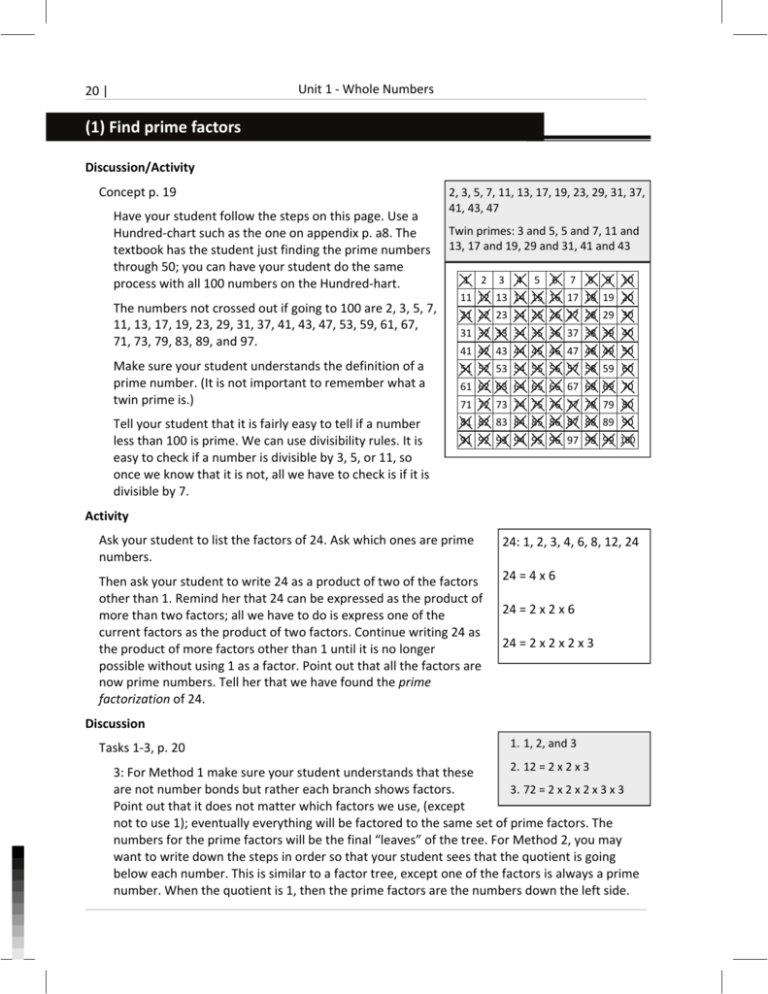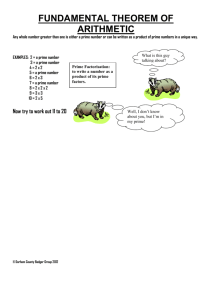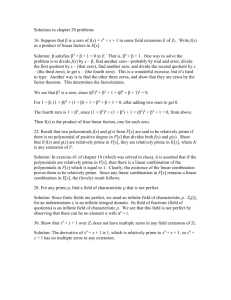(1) Find prime factors
advertisement

Unit 1 - Whole Numbers 20 | (1) Find prime factors Discussion/Activity Concept p. 19 Have your student follow the steps on this page. Use a Hundred-chart such as the one on appendix p. a8. The textbook has the student just finding the prime numbers through 50; you can have your student do the same process with all 100 numbers on the Hundred-hart. The numbers not crossed out if going to 100 are 2, 3, 5, 7, 11, 13, 17, 19, 23, 29, 31, 37, 41, 43, 47, 53, 59, 61, 67, 71, 73, 79, 83, 89, and 97. 2, 3, 5, 7, 11, 13, 17, 19, 23, 29, 31, 37, 41, 43, 47 Twin primes: 3 and 5, 5 and 7, 11 and 13, 17 and 19, 29 and 31, 41 and 43 1 2 3 4 5 6 7 8 9 10 11 12 13 14 15 16 17 18 19 20 21 22 23 24 25 26 27 28 29 30 31 32 33 34 35 36 37 38 39 40 41 42 43 44 45 46 47 48 49 50 Make sure your student understands the definition of a prime number. (It is not important to remember what a twin prime is.) 51 52 53 54 55 56 57 58 59 60 Tell your student that it is fairly easy to tell if a number less than 100 is prime. We can use divisibility rules. It is easy to check if a number is divisible by 3, 5, or 11, so once we know that it is not, all we have to check is if it is divisible by 7. 81 82 83 84 85 86 87 88 89 90 61 62 63 64 65 66 67 68 69 70 71 72 73 74 75 76 77 78 79 80 91 92 93 94 95 96 97 98 99 100 Activity Ask your student to list the factors of 24. Ask which ones are prime numbers. 24: 1, 2, 3, 4, 6, 8, 12, 24 Then ask your student to write 24 as a product of two of the factors other than 1. Remind her that 24 can be expressed as the product of more than two factors; all we have to do is express one of the current factors as the product of two factors. Continue writing 24 as the product of more factors other than 1 until it is no longer possible without using 1 as a factor. Point out that all the factors are now prime numbers. Tell her that we have found the prime factorization of 24. 24 = 4 x 6 24 = 2 x 2 x 6 24 = 2 x 2 x 2 x 3 Discussion Tasks 1-3, p. 20 1. 1, 2, and 3 2. 12 = 2 x 2 x 3 3: For Method 1 make sure your student understands that these are not number bonds but rather each branch shows factors. 3. 72 = 2 x 2 x 2 x 3 x 3 Point out that it does not matter which factors we use, (except not to use 1); eventually everything will be factored to the same set of prime factors. The numbers for the prime factors will be the final “leaves” of the tree. For Method 2, you may want to write down the steps in order so that your student sees that the quotient is going below each number. This is similar to a factor tree, except one of the factors is always a prime number. When the quotient is 1, then the prime factors are the numbers down the left side.








